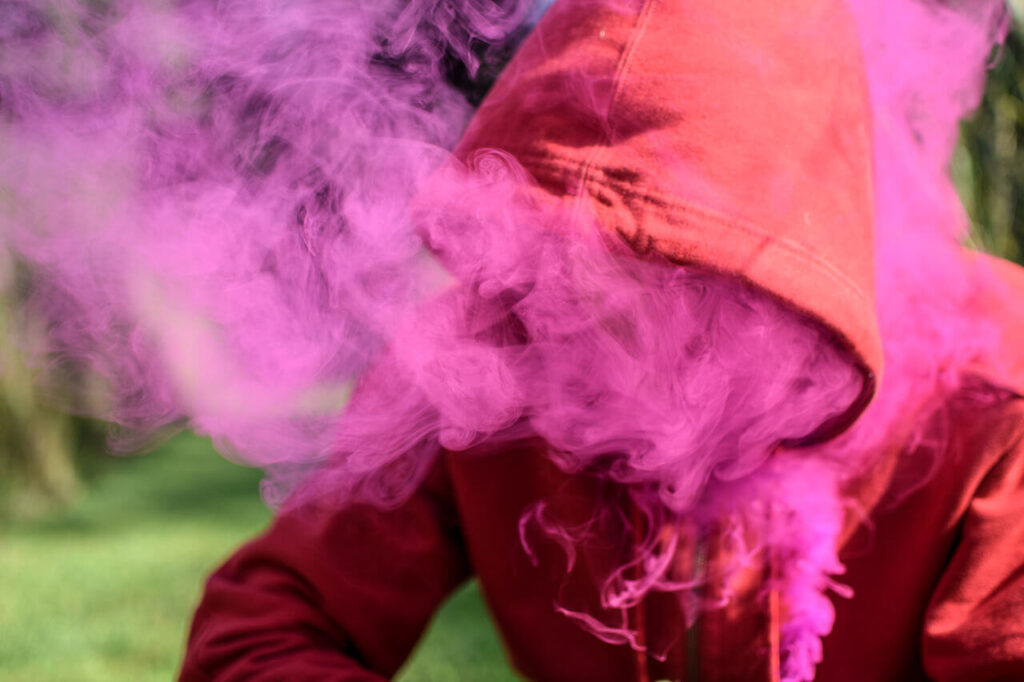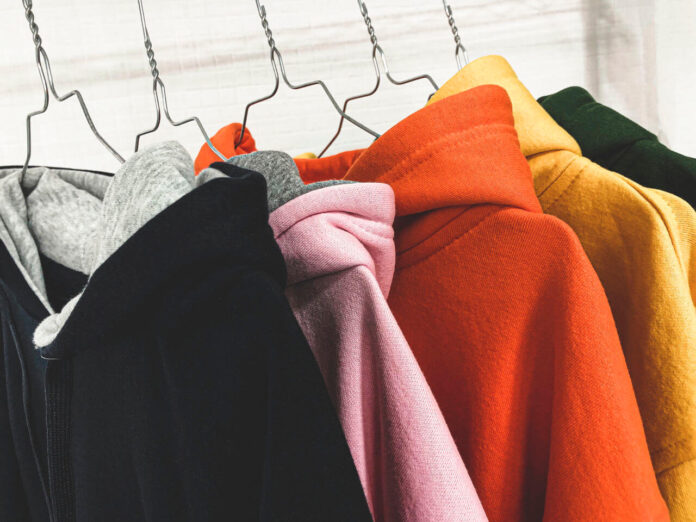You need a fabric that is soft, compact, airy, and sweat-absorbent if you’re going to wear a hoodie.
Before choosing the type of best fabric for hoodies, it’s crucial to think about how you plan to wear them. Your choice will be influenced by your understanding of the item’s intended usage.
Understanding the purpose of your clothing can help you choose the proper fabric manufacturer because each one offers varying degrees of breathability, durability, and flexibility.
Both cotton and denim are suitable materials for hoodies, with cotton being the most popular option. You can easily clean it, and it keeps you warmer and aids with breathing. But if you want to be warm, get a quality fleece fabric. It is significantly superior to cotton.
Just keep reading our article to discover more about the ideal hoodie fabric material.


What Materials Are Used For Hoodies?
Hoodies can be made from a wide variety of high-quality materials. Your choice will, of course, depend on your specific preferences or allergies. Some folks will exclusively make their apparel from natural fibers, including hoodies.
There are many excellent options available; you can choose from a wide range of your best hoodie fabric material. Whether you want to be perceived as a traditionalist or as someone who thinks outside the box will all depend on your goals.
However, it will depend on if you frequently go trekking or mountain climbing or the local weather where you live. You should choose a nylon or fleece fabric for the latter two activities. The moisture should be driven away as rapidly as possible while maintaining your body temperature.
The majority of custom hoodie manufacturer makes hoodies from these materials that will be appropriate for cool evenings.
Cotton


Without a question, cotton is the most widely used fabric for clothing. Cotton is a naturally occurring fiber that is very absorbent. Cotton fabric for hoodies is primarily worn for casual and athletic purposes. Even during vigorous activity, the substance aids in maintaining the body’s moisture.
A cotton fabric hoodie material will also ensure that you are comfortable when working long hours and won’t leave you feeling worn out. Since cotton is a fairly light fiber, it provides the body with exceptional flexibility. To make diverse fabric blends like polyester, cotton fibers are mixed with a variety of other fibers.
Fleece


Only in the winter do fleece hoodies function. Fleece hoodies should be a wonderful option if you’re looking to give personalized sweatshirts to your staff to keep them warm during the winter. Cotton and wool are the main components of fleece, a plush and cozy fabric.
These hoodies are appropriate for campers and hikers who ascend high hills while clearing a path through the snow. One benefit of utilizing fleece for your hoodies is that it is simple to maintain because fleece does not absorb stains as readily. Additionally, you can combine fleece with different fabric kinds to give your hoodie greater durability.
Jersey


You should wear a hoodie made of cotton jersey material if you plan to conduct a lot of physical activity while wearing it. You have all the advantages of cotton and more from this material.
Additionally, in some circumstances it stretches up to 25%, ensuring that you have the movement required to complete your tasks. The fabric is excellent for gardening because it will keep you warm as you trim dead leaves or dig a hole for your new plant.
The hoodie should then be simple to clean since it is composed of cotton. It will be ready when you are if you simply wash it like you would any cotton jersey knit. Additionally, the cotton jersey is a simple and potentially inexpensive fabric to find.
Nylon


Synthetic nylon has a shiny appearance and offers clothing a beautiful fall. Although nylon is a less popular material option, it can be a suitable choice if you only intend to use the hoodies for one particular nighttime event or party. Hoodies made of nylon are appropriate for the rainy season since the fabric’s fibers resist water absorption. To develop a novel fabric blend, nylon can also be blended with other materials.
Let’s examine the typical fabrics used to create bespoke hoodies to determine what the perfect qualities of a hoodie fabric type are. Depending on your objective, these will enable you to choose the appropriate cloth.
Spandex


Spandex is a flexible synthetic fabric that is also known as elastane, after the fiber by which it is named. Spandex has Lycra in it, which provides it with stretch and flexibility.
Because it has limited durability and longevity when used alone and is subject to wear and tear, spandex performs best when mixed into other best materials for hoodies. A simple approach to give a hoodie stretch and flexibility is to combine cotton with spandex. This is frequently observed in athletic clothing with red hoodie cuff material that adheres to its look.
While engaging in vigorous activity, the spandex helps the cotton become more resilient and provides a wider range of motion.
Cotton/Polyester Blends


Given that both polyester and cotton are synthetic materials, it makes natural that they would be combined to create a single fabric. This combination has various advantages, including good color retention, resistance to environmental fading from things like sunlight, quick sweat absorption, and quick drying.
Polyester resists water, keeping your body dry even when you’re drenched in perspiration. This will lessen the likelihood of daylong chafing as well as other irritation brought on by the buildup beneath your clothing.
Polyester can be incorporated into other textiles, like cotton. It increases the fabric’s elasticity while maintaining its comfort and breathability. While engaging in vigorous activity, the spandex helps the cotton become more resilient and provides a wider range of motion.
Wool


Wool material gives warmth and excellent breathability even when worn close to the skin, wool is one of the best natural textiles for hoodies.
Due to its long history of use in clothing, wool has a rich history. In addition to being comfortable, wool is also incredibly strong and resistant to all kinds of weather.
Allergy sufferers can think about wearing wool to avoid irritation brought on by other textiles like cotton or polyester. Wool is a fabric that naturally resists water, making it perfect for keeping dry when exposed to rain or snow.
Additionally, wool retains its shape better than many synthetic fabrics, so your hoodie will last longer with less wear and tear.
What Is The Warmest Material For A Hoodie?
Wool, cotton, polyester, nylon, or a blend of cotton and polyester are the most common materials used to make extra-warm hoodies. This is because those two materials tend to be extremely adaptable, resilient, and insulating.
Buying Guides For What Materials Are Used For Hoodies:
The ideal fabric for hoodie material types is pleasant to wear and flexible. For loose-fitting hoodies, materials like fleece, jersey knits, and sweatshirt fabric work well. They are comfortable and give you room to move. How to find a clothing manufacturer who gives a try to hoodie fabric for double knit, cotton lycra, or rayon for a slimmer look.


Fitting
Typically, hoodies are sold in one size fits all. As a result, the fabric hoodie you use should be stretchy and flexible. Because they are mostly worn as informal clothing, hoodies need to be somewhat stretchy. Your users won’t find your hoodies comfortable to wear if the fabric isn’t stretchable. When hoodies are made for sporting events, the chosen fabric should have a high degree of elasticity.


Comfort
The weight of a hoodie should strike a balance between warmth and flexibility. Only the fact that hoodies are lightweight and comfortable makes people want to wear them. People won’t buy your hoodies if they are overly bulky. Winter-appropriate hoodies may be a little heavier than usual to increase the fabric’s warmth. Hoodies must be lightweight for use in casual and athletic clothing.


Durability
When buying sporting or winter clothing, durability should be your top concern. Different fabric varieties have different levels of durability. The wear and tear of an active lifestyle and the natural elements are typically not a problem for fleece or synthetic fabric. If you prefer a different outside appearance, you can alternatively choose a fleece lining.
How long the item stays in your closet will also depend on how durable the cloth is. After the first few washes, a weak fabric may begin to pill or fade. Investing in a piece of clothes made of a robust material ensures that it will last a long time in your closet.


Leisure
You and your body should be comfortable with the fabric you chose for your hoodie. If you have a polyester allergy, there is no use in choosing a polyester blend.
You need the best hoodie fabric that is more durable the more active your lifestyle is. For instance, frequent washing can make some textiles fade or pill. You don’t want your hoodie to start disintegrating after a couple of loads of laundry. Especially if you require it to keep you warm during the winter’s cold season.
What Materials Are Used For Hoodies Or Can You Use Any Fabric For a Hoodie?
Hoodies cannot be made from all fabric. Although you can produce your hoodie out of a variety of materials, some don’t have the characteristics a good hoodie needs.
Hoodies work best in warm, elastic, lightweight fabrics, as we’ve seen in this essay. Fleece and other knit materials, such as jerseys, are some of the greatest materials for hoodies. The comfort factor is one of the main reasons knit fabrics, in particular, work so well in hoodies.
Conclusion
So, how to make a hoodie material works best for you? It all depends on what you’re after. Choose cotton if you want something warm and comfortable. Try nylon or sweatshirt knit if you’re searching for something more breathable and light and many other different hoodie materials according to your preference.
Additionally, choose a jersey or fleece if you want something incredibly soft and cozy. A hoodie is a wardrobe staple that works with any material.




